Organizational Behaviour: Samsung, Motivation, and Team Dynamics
VerifiedAdded on 2020/10/22
|14
|3671
|444
Report
AI Summary
This report on organizational behaviour examines the influence of organizational culture, politics, and power on individual behaviour and team performance, using Samsung as a case study. It explores different types of organizational culture, the impact of workplace politics, and the role o...
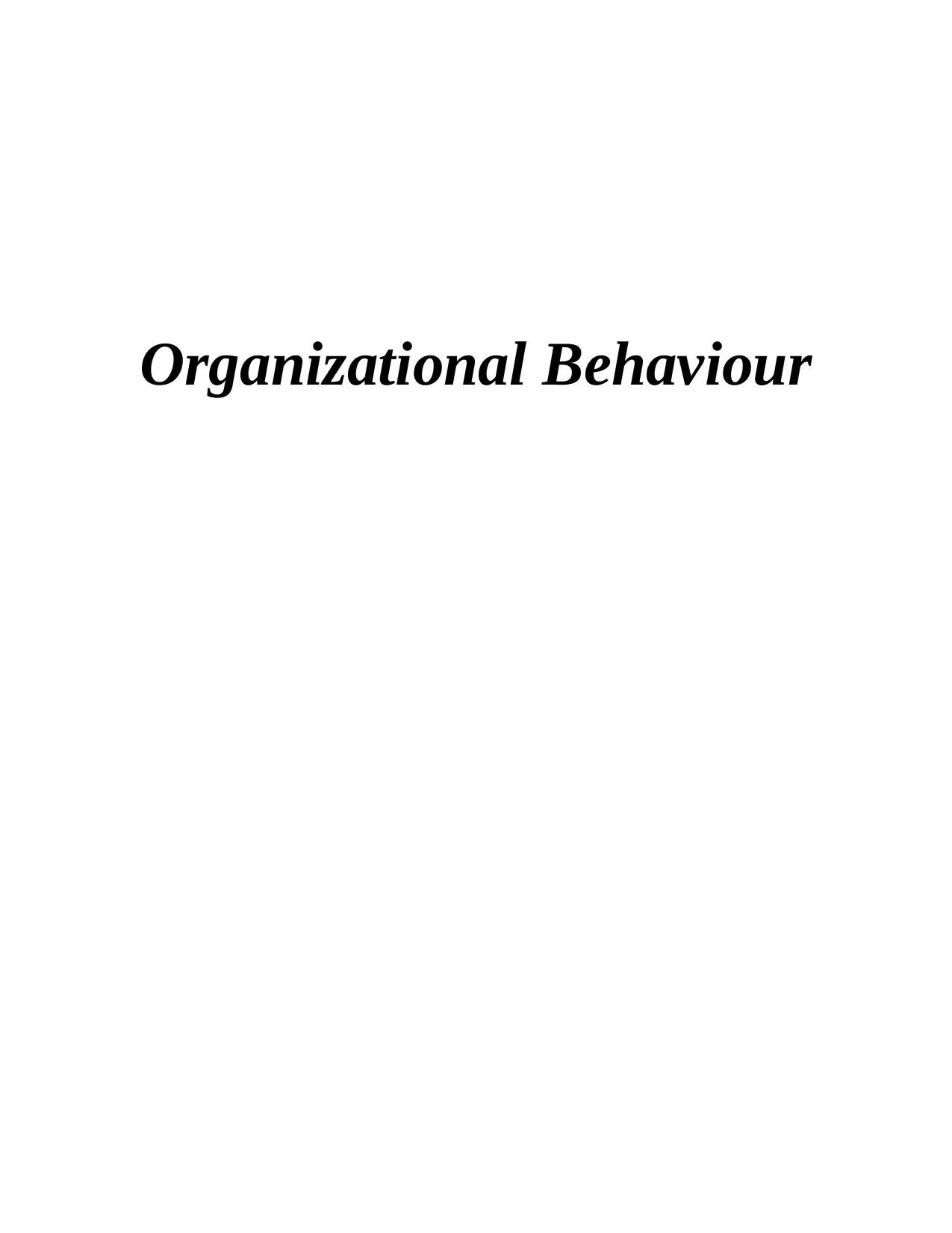
Organizational Behaviour
Secure Best Marks with AI Grader
Need help grading? Try our AI Grader for instant feedback on your assignments.
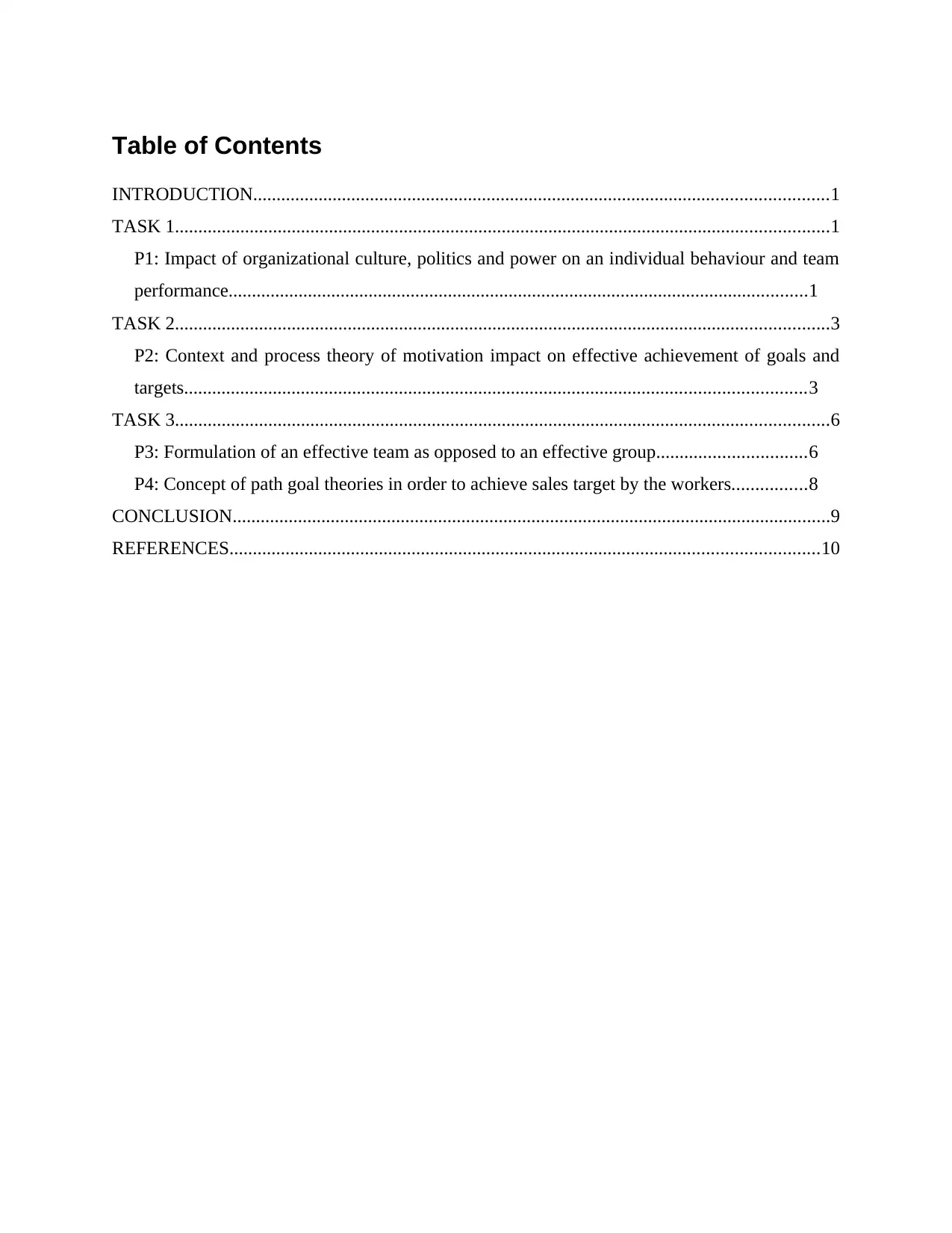
Table of Contents
INTRODUCTION...........................................................................................................................1
TASK 1............................................................................................................................................1
P1: Impact of organizational culture, politics and power on an individual behaviour and team
performance............................................................................................................................1
TASK 2............................................................................................................................................3
P2: Context and process theory of motivation impact on effective achievement of goals and
targets.....................................................................................................................................3
TASK 3............................................................................................................................................6
P3: Formulation of an effective team as opposed to an effective group................................6
P4: Concept of path goal theories in order to achieve sales target by the workers................8
CONCLUSION................................................................................................................................9
REFERENCES..............................................................................................................................10
INTRODUCTION...........................................................................................................................1
TASK 1............................................................................................................................................1
P1: Impact of organizational culture, politics and power on an individual behaviour and team
performance............................................................................................................................1
TASK 2............................................................................................................................................3
P2: Context and process theory of motivation impact on effective achievement of goals and
targets.....................................................................................................................................3
TASK 3............................................................................................................................................6
P3: Formulation of an effective team as opposed to an effective group................................6
P4: Concept of path goal theories in order to achieve sales target by the workers................8
CONCLUSION................................................................................................................................9
REFERENCES..............................................................................................................................10
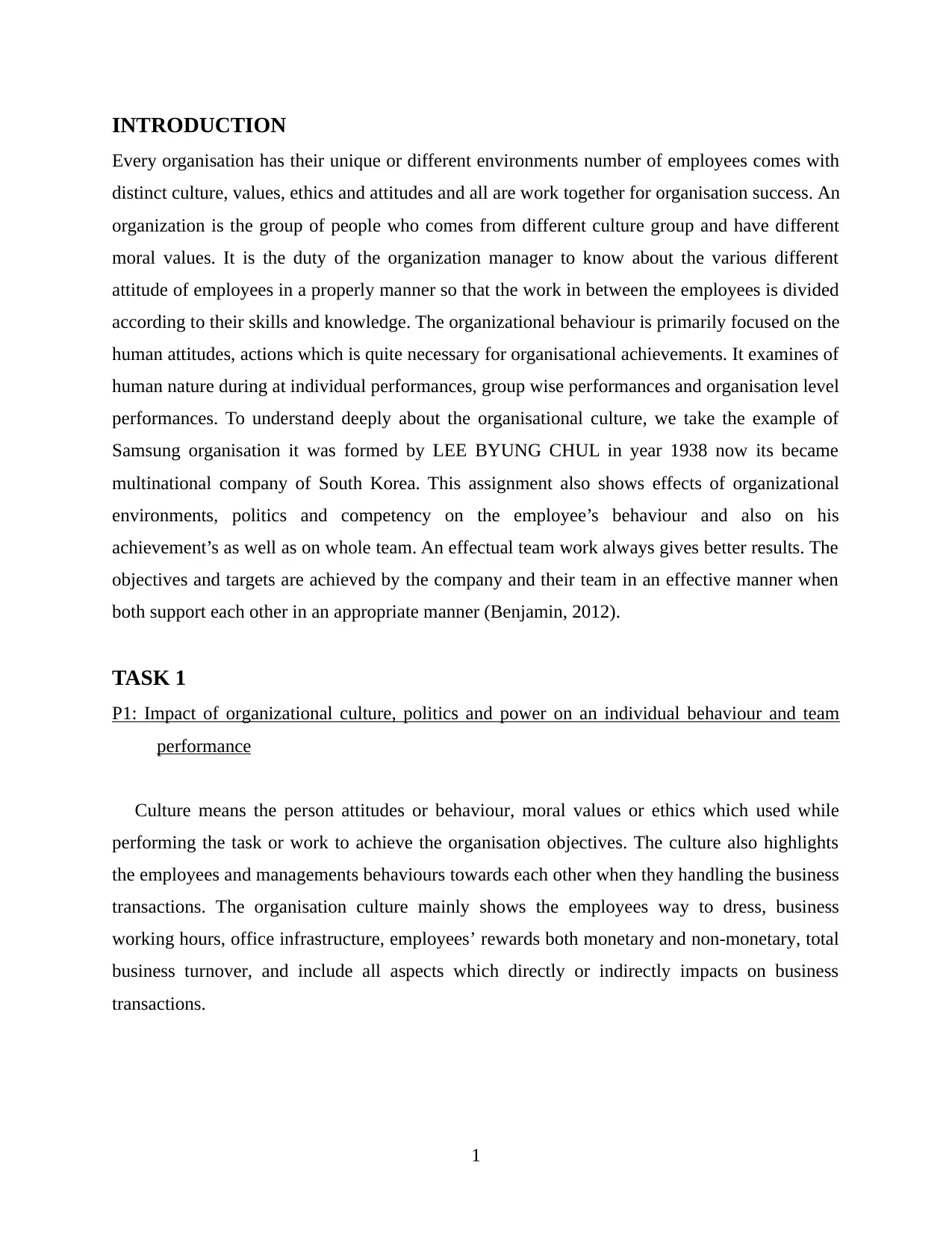
INTRODUCTION
Every organisation has their unique or different environments number of employees comes with
distinct culture, values, ethics and attitudes and all are work together for organisation success. An
organization is the group of people who comes from different culture group and have different
moral values. It is the duty of the organization manager to know about the various different
attitude of employees in a properly manner so that the work in between the employees is divided
according to their skills and knowledge. The organizational behaviour is primarily focused on the
human attitudes, actions which is quite necessary for organisational achievements. It examines of
human nature during at individual performances, group wise performances and organisation level
performances. To understand deeply about the organisational culture, we take the example of
Samsung organisation it was formed by LEE BYUNG CHUL in year 1938 now its became
multinational company of South Korea. This assignment also shows effects of organizational
environments, politics and competency on the employee’s behaviour and also on his
achievement’s as well as on whole team. An effectual team work always gives better results. The
objectives and targets are achieved by the company and their team in an effective manner when
both support each other in an appropriate manner (Benjamin, 2012).
TASK 1
P1: Impact of organizational culture, politics and power on an individual behaviour and team
performance
Culture means the person attitudes or behaviour, moral values or ethics which used while
performing the task or work to achieve the organisation objectives. The culture also highlights
the employees and managements behaviours towards each other when they handling the business
transactions. The organisation culture mainly shows the employees way to dress, business
working hours, office infrastructure, employees’ rewards both monetary and non-monetary, total
business turnover, and include all aspects which directly or indirectly impacts on business
transactions.
1
Every organisation has their unique or different environments number of employees comes with
distinct culture, values, ethics and attitudes and all are work together for organisation success. An
organization is the group of people who comes from different culture group and have different
moral values. It is the duty of the organization manager to know about the various different
attitude of employees in a properly manner so that the work in between the employees is divided
according to their skills and knowledge. The organizational behaviour is primarily focused on the
human attitudes, actions which is quite necessary for organisational achievements. It examines of
human nature during at individual performances, group wise performances and organisation level
performances. To understand deeply about the organisational culture, we take the example of
Samsung organisation it was formed by LEE BYUNG CHUL in year 1938 now its became
multinational company of South Korea. This assignment also shows effects of organizational
environments, politics and competency on the employee’s behaviour and also on his
achievement’s as well as on whole team. An effectual team work always gives better results. The
objectives and targets are achieved by the company and their team in an effective manner when
both support each other in an appropriate manner (Benjamin, 2012).
TASK 1
P1: Impact of organizational culture, politics and power on an individual behaviour and team
performance
Culture means the person attitudes or behaviour, moral values or ethics which used while
performing the task or work to achieve the organisation objectives. The culture also highlights
the employees and managements behaviours towards each other when they handling the business
transactions. The organisation culture mainly shows the employees way to dress, business
working hours, office infrastructure, employees’ rewards both monetary and non-monetary, total
business turnover, and include all aspects which directly or indirectly impacts on business
transactions.
1
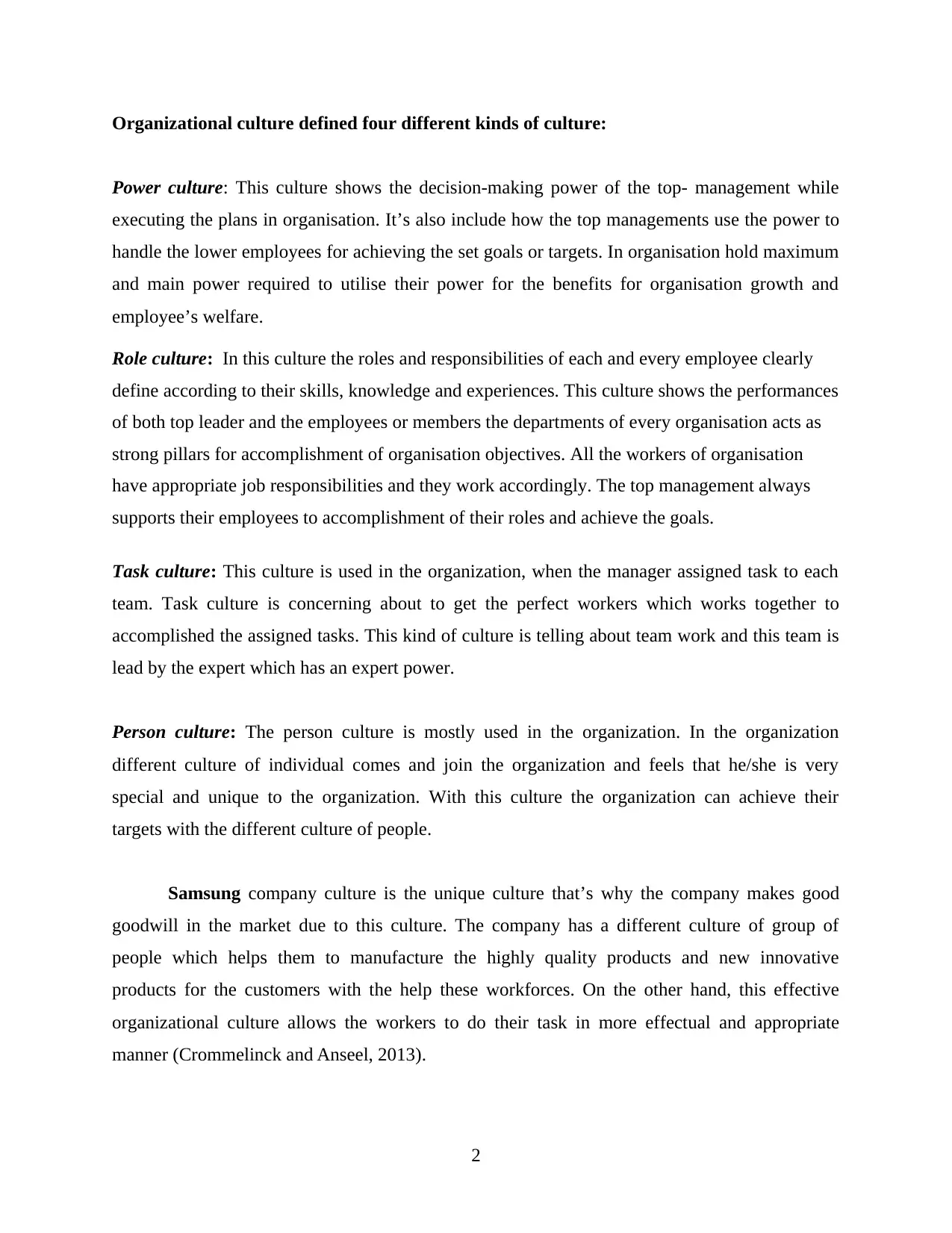
Organizational culture defined four different kinds of culture:
Power culture: This culture shows the decision-making power of the top- management while
executing the plans in organisation. It’s also include how the top managements use the power to
handle the lower employees for achieving the set goals or targets. In organisation hold maximum
and main power required to utilise their power for the benefits for organisation growth and
employee’s welfare.
Role culture: In this culture the roles and responsibilities of each and every employee clearly
define according to their skills, knowledge and experiences. This culture shows the performances
of both top leader and the employees or members the departments of every organisation acts as
strong pillars for accomplishment of organisation objectives. All the workers of organisation
have appropriate job responsibilities and they work accordingly. The top management always
supports their employees to accomplishment of their roles and achieve the goals.
Task culture: This culture is used in the organization, when the manager assigned task to each
team. Task culture is concerning about to get the perfect workers which works together to
accomplished the assigned tasks. This kind of culture is telling about team work and this team is
lead by the expert which has an expert power.
Person culture: The person culture is mostly used in the organization. In the organization
different culture of individual comes and join the organization and feels that he/she is very
special and unique to the organization. With this culture the organization can achieve their
targets with the different culture of people.
Samsung company culture is the unique culture that’s why the company makes good
goodwill in the market due to this culture. The company has a different culture of group of
people which helps them to manufacture the highly quality products and new innovative
products for the customers with the help these workforces. On the other hand, this effective
organizational culture allows the workers to do their task in more effectual and appropriate
manner (Crommelinck and Anseel, 2013).
2
Power culture: This culture shows the decision-making power of the top- management while
executing the plans in organisation. It’s also include how the top managements use the power to
handle the lower employees for achieving the set goals or targets. In organisation hold maximum
and main power required to utilise their power for the benefits for organisation growth and
employee’s welfare.
Role culture: In this culture the roles and responsibilities of each and every employee clearly
define according to their skills, knowledge and experiences. This culture shows the performances
of both top leader and the employees or members the departments of every organisation acts as
strong pillars for accomplishment of organisation objectives. All the workers of organisation
have appropriate job responsibilities and they work accordingly. The top management always
supports their employees to accomplishment of their roles and achieve the goals.
Task culture: This culture is used in the organization, when the manager assigned task to each
team. Task culture is concerning about to get the perfect workers which works together to
accomplished the assigned tasks. This kind of culture is telling about team work and this team is
lead by the expert which has an expert power.
Person culture: The person culture is mostly used in the organization. In the organization
different culture of individual comes and join the organization and feels that he/she is very
special and unique to the organization. With this culture the organization can achieve their
targets with the different culture of people.
Samsung company culture is the unique culture that’s why the company makes good
goodwill in the market due to this culture. The company has a different culture of group of
people which helps them to manufacture the highly quality products and new innovative
products for the customers with the help these workforces. On the other hand, this effective
organizational culture allows the workers to do their task in more effectual and appropriate
manner (Crommelinck and Anseel, 2013).
2
Secure Best Marks with AI Grader
Need help grading? Try our AI Grader for instant feedback on your assignments.
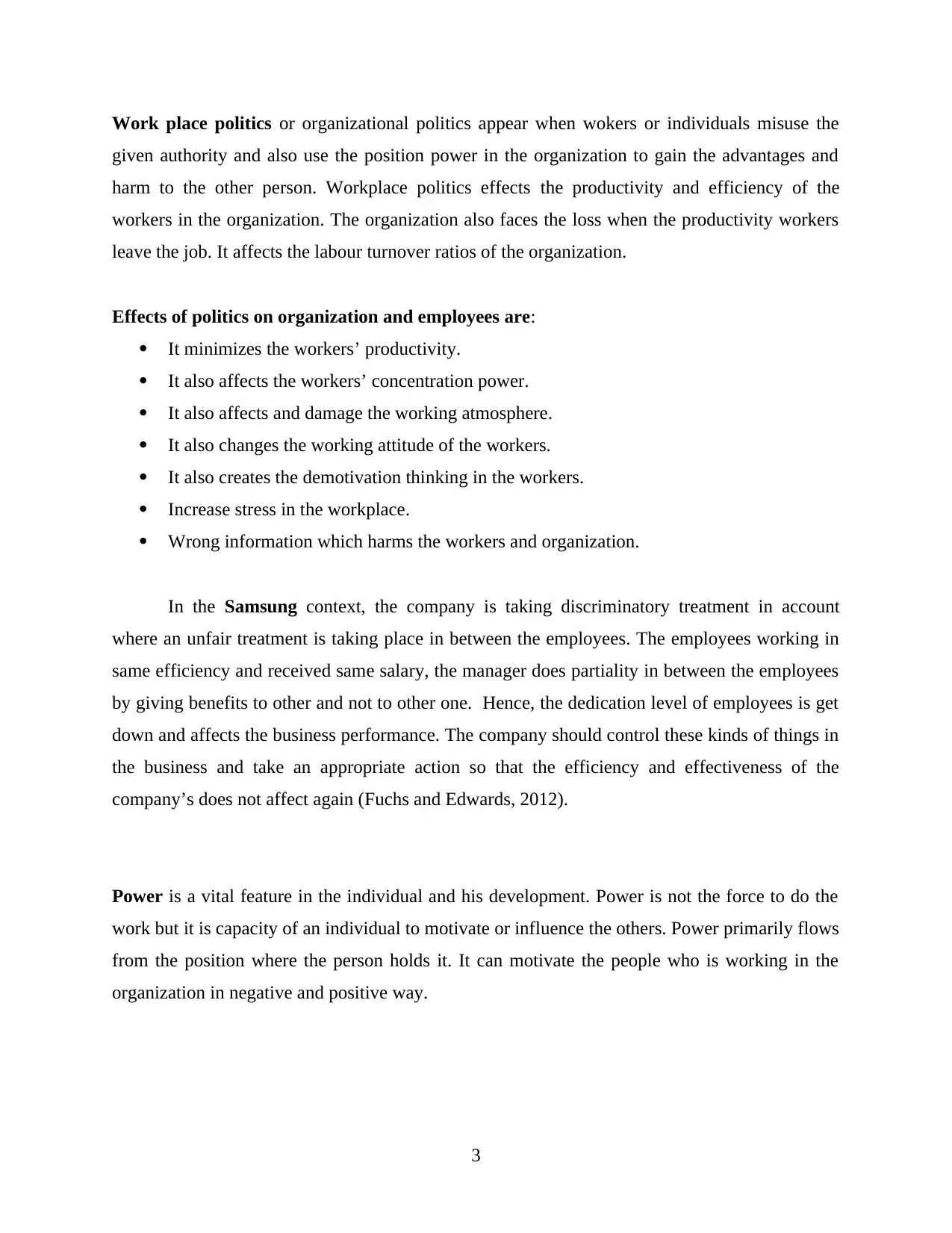
Work place politics or organizational politics appear when wokers or individuals misuse the
given authority and also use the position power in the organization to gain the advantages and
harm to the other person. Workplace politics effects the productivity and efficiency of the
workers in the organization. The organization also faces the loss when the productivity workers
leave the job. It affects the labour turnover ratios of the organization.
Effects of politics on organization and employees are:
It minimizes the workers’ productivity.
It also affects the workers’ concentration power.
It also affects and damage the working atmosphere.
It also changes the working attitude of the workers.
It also creates the demotivation thinking in the workers.
Increase stress in the workplace.
Wrong information which harms the workers and organization.
In the Samsung context, the company is taking discriminatory treatment in account
where an unfair treatment is taking place in between the employees. The employees working in
same efficiency and received same salary, the manager does partiality in between the employees
by giving benefits to other and not to other one. Hence, the dedication level of employees is get
down and affects the business performance. The company should control these kinds of things in
the business and take an appropriate action so that the efficiency and effectiveness of the
company’s does not affect again (Fuchs and Edwards, 2012).
Power is a vital feature in the individual and his development. Power is not the force to do the
work but it is capacity of an individual to motivate or influence the others. Power primarily flows
from the position where the person holds it. It can motivate the people who is working in the
organization in negative and positive way.
3
given authority and also use the position power in the organization to gain the advantages and
harm to the other person. Workplace politics effects the productivity and efficiency of the
workers in the organization. The organization also faces the loss when the productivity workers
leave the job. It affects the labour turnover ratios of the organization.
Effects of politics on organization and employees are:
It minimizes the workers’ productivity.
It also affects the workers’ concentration power.
It also affects and damage the working atmosphere.
It also changes the working attitude of the workers.
It also creates the demotivation thinking in the workers.
Increase stress in the workplace.
Wrong information which harms the workers and organization.
In the Samsung context, the company is taking discriminatory treatment in account
where an unfair treatment is taking place in between the employees. The employees working in
same efficiency and received same salary, the manager does partiality in between the employees
by giving benefits to other and not to other one. Hence, the dedication level of employees is get
down and affects the business performance. The company should control these kinds of things in
the business and take an appropriate action so that the efficiency and effectiveness of the
company’s does not affect again (Fuchs and Edwards, 2012).
Power is a vital feature in the individual and his development. Power is not the force to do the
work but it is capacity of an individual to motivate or influence the others. Power primarily flows
from the position where the person holds it. It can motivate the people who is working in the
organization in negative and positive way.
3
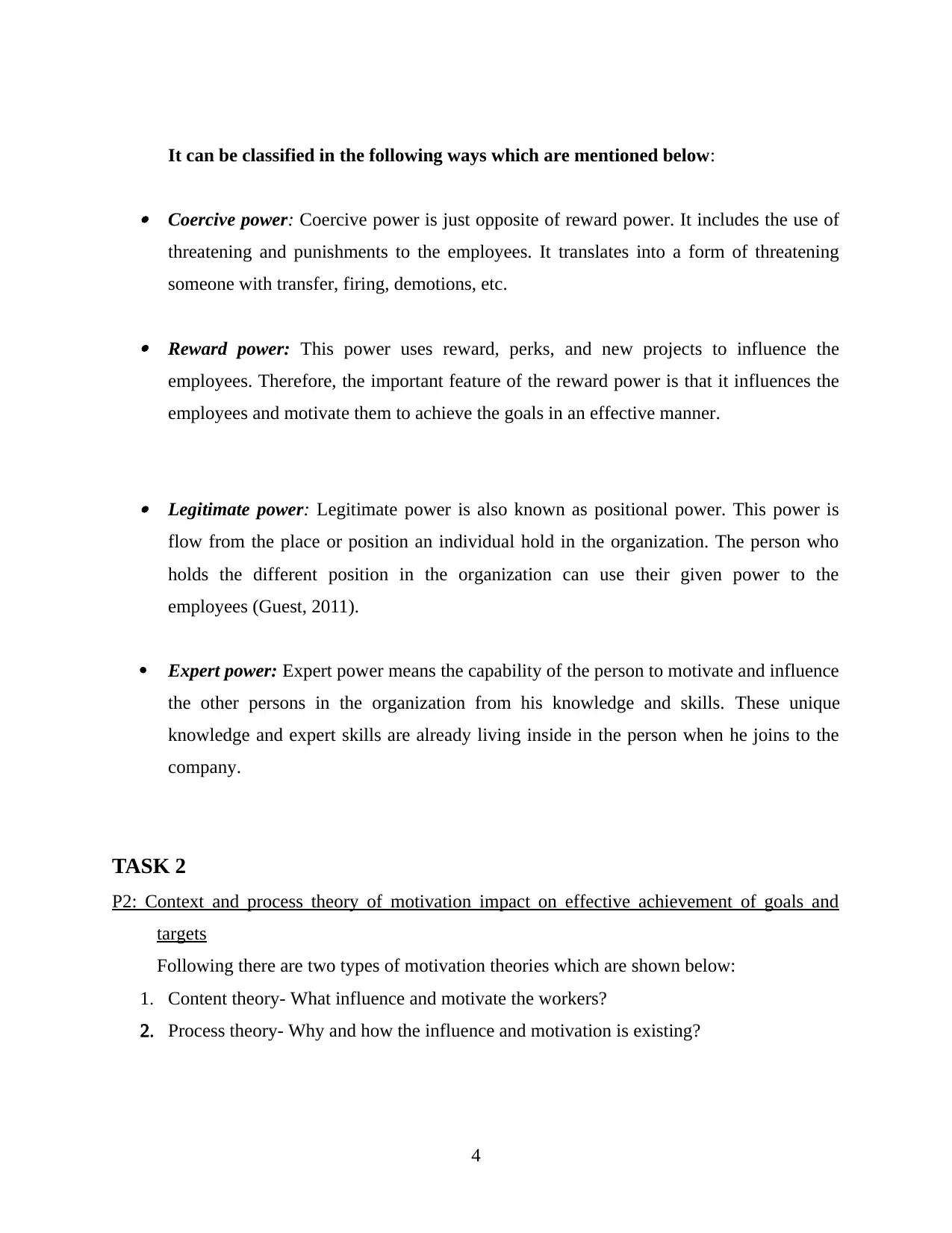
It can be classified in the following ways which are mentioned below:
Coercive power: Coercive power is just opposite of reward power. It includes the use of
threatening and punishments to the employees. It translates into a form of threatening
someone with transfer, firing, demotions, etc.
Reward power: This power uses reward, perks, and new projects to influence the
employees. Therefore, the important feature of the reward power is that it influences the
employees and motivate them to achieve the goals in an effective manner.
Legitimate power: Legitimate power is also known as positional power. This power is
flow from the place or position an individual hold in the organization. The person who
holds the different position in the organization can use their given power to the
employees (Guest, 2011).
Expert power: Expert power means the capability of the person to motivate and influence
the other persons in the organization from his knowledge and skills. These unique
knowledge and expert skills are already living inside in the person when he joins to the
company.
TASK 2
P2: Context and process theory of motivation impact on effective achievement of goals and
targets
Following there are two types of motivation theories which are shown below:
1. Content theory- What influence and motivate the workers?
2. Process theory- Why and how the influence and motivation is existing?
4
Coercive power: Coercive power is just opposite of reward power. It includes the use of
threatening and punishments to the employees. It translates into a form of threatening
someone with transfer, firing, demotions, etc.
Reward power: This power uses reward, perks, and new projects to influence the
employees. Therefore, the important feature of the reward power is that it influences the
employees and motivate them to achieve the goals in an effective manner.
Legitimate power: Legitimate power is also known as positional power. This power is
flow from the place or position an individual hold in the organization. The person who
holds the different position in the organization can use their given power to the
employees (Guest, 2011).
Expert power: Expert power means the capability of the person to motivate and influence
the other persons in the organization from his knowledge and skills. These unique
knowledge and expert skills are already living inside in the person when he joins to the
company.
TASK 2
P2: Context and process theory of motivation impact on effective achievement of goals and
targets
Following there are two types of motivation theories which are shown below:
1. Content theory- What influence and motivate the workers?
2. Process theory- Why and how the influence and motivation is existing?
4

Content theory: This theory mainly concentrates on inner factors of the workers in the
organization which activate them to do their work in the more effective manner and
accomplishment of goals within the time frame.
This theory contain main three theories of the following persons are:
Herzberg’s motivator- hygiene theory
Maslow’s hierarchy of needs McClelland’s three- needs theory
Motivation- hygiene theory: - According to Herzberg, this theory disclosed that there are certain
features and factors of a job which are always makes job satisfaction and dissatisfaction to the
employees (Reviewing Three Approaches to Motivation, 2017).
Satisfies: Motivators factors
Dissatisfies: Hygiene factors
Hygiene or dissatisfaction factors are:
Relations and connection with seniors.
Relations and connection with subordinates.
Salary or pay structure.
Working environment.
Supervision
Policies of organization.
Motivating factors are:
Recognition
Achievement
Work itself
Growth
Advancement Responsibility
5
organization which activate them to do their work in the more effective manner and
accomplishment of goals within the time frame.
This theory contain main three theories of the following persons are:
Herzberg’s motivator- hygiene theory
Maslow’s hierarchy of needs McClelland’s three- needs theory
Motivation- hygiene theory: - According to Herzberg, this theory disclosed that there are certain
features and factors of a job which are always makes job satisfaction and dissatisfaction to the
employees (Reviewing Three Approaches to Motivation, 2017).
Satisfies: Motivators factors
Dissatisfies: Hygiene factors
Hygiene or dissatisfaction factors are:
Relations and connection with seniors.
Relations and connection with subordinates.
Salary or pay structure.
Working environment.
Supervision
Policies of organization.
Motivating factors are:
Recognition
Achievement
Work itself
Growth
Advancement Responsibility
5
Paraphrase This Document
Need a fresh take? Get an instant paraphrase of this document with our AI Paraphraser
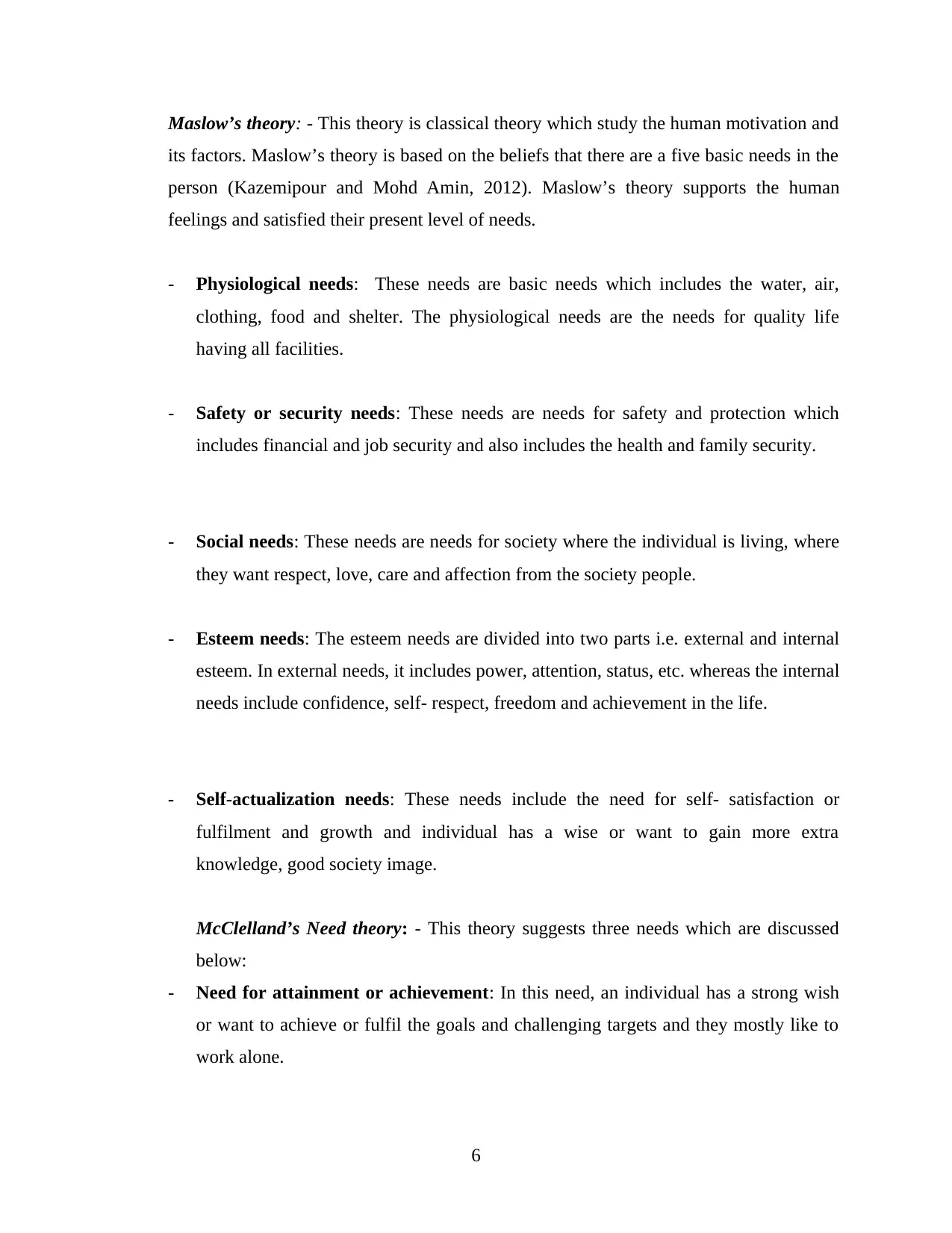
Maslow’s theory: - This theory is classical theory which study the human motivation and
its factors. Maslow’s theory is based on the beliefs that there are a five basic needs in the
person (Kazemipour and Mohd Amin, 2012). Maslow’s theory supports the human
feelings and satisfied their present level of needs.
- Physiological needs: These needs are basic needs which includes the water, air,
clothing, food and shelter. The physiological needs are the needs for quality life
having all facilities.
- Safety or security needs: These needs are needs for safety and protection which
includes financial and job security and also includes the health and family security.
- Social needs: These needs are needs for society where the individual is living, where
they want respect, love, care and affection from the society people.
- Esteem needs: The esteem needs are divided into two parts i.e. external and internal
esteem. In external needs, it includes power, attention, status, etc. whereas the internal
needs include confidence, self- respect, freedom and achievement in the life.
- Self-actualization needs: These needs include the need for self- satisfaction or
fulfilment and growth and individual has a wise or want to gain more extra
knowledge, good society image.
McClelland’s Need theory: - This theory suggests three needs which are discussed
below:
- Need for attainment or achievement: In this need, an individual has a strong wish
or want to achieve or fulfil the goals and challenging targets and they mostly like to
work alone.
6
its factors. Maslow’s theory is based on the beliefs that there are a five basic needs in the
person (Kazemipour and Mohd Amin, 2012). Maslow’s theory supports the human
feelings and satisfied their present level of needs.
- Physiological needs: These needs are basic needs which includes the water, air,
clothing, food and shelter. The physiological needs are the needs for quality life
having all facilities.
- Safety or security needs: These needs are needs for safety and protection which
includes financial and job security and also includes the health and family security.
- Social needs: These needs are needs for society where the individual is living, where
they want respect, love, care and affection from the society people.
- Esteem needs: The esteem needs are divided into two parts i.e. external and internal
esteem. In external needs, it includes power, attention, status, etc. whereas the internal
needs include confidence, self- respect, freedom and achievement in the life.
- Self-actualization needs: These needs include the need for self- satisfaction or
fulfilment and growth and individual has a wise or want to gain more extra
knowledge, good society image.
McClelland’s Need theory: - This theory suggests three needs which are discussed
below:
- Need for attainment or achievement: In this need, an individual has a strong wish
or want to achieve or fulfil the goals and challenging targets and they mostly like to
work alone.
6
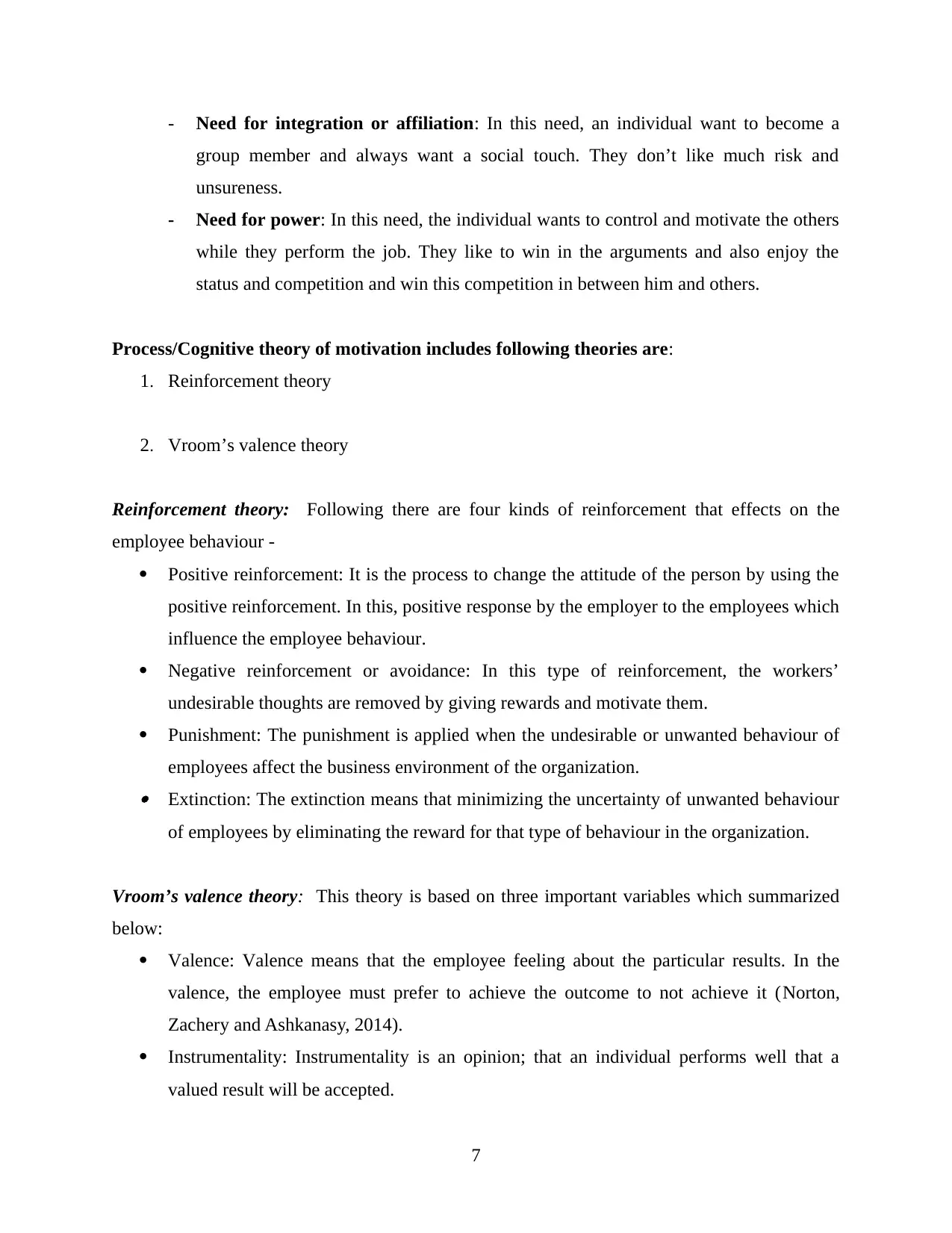
- Need for integration or affiliation: In this need, an individual want to become a
group member and always want a social touch. They don’t like much risk and
unsureness.
- Need for power: In this need, the individual wants to control and motivate the others
while they perform the job. They like to win in the arguments and also enjoy the
status and competition and win this competition in between him and others.
Process/Cognitive theory of motivation includes following theories are:
1. Reinforcement theory
2. Vroom’s valence theory
Reinforcement theory: Following there are four kinds of reinforcement that effects on the
employee behaviour -
Positive reinforcement: It is the process to change the attitude of the person by using the
positive reinforcement. In this, positive response by the employer to the employees which
influence the employee behaviour.
Negative reinforcement or avoidance: In this type of reinforcement, the workers’
undesirable thoughts are removed by giving rewards and motivate them.
Punishment: The punishment is applied when the undesirable or unwanted behaviour of
employees affect the business environment of the organization. Extinction: The extinction means that minimizing the uncertainty of unwanted behaviour
of employees by eliminating the reward for that type of behaviour in the organization.
Vroom’s valence theory: This theory is based on three important variables which summarized
below:
Valence: Valence means that the employee feeling about the particular results. In the
valence, the employee must prefer to achieve the outcome to not achieve it (Norton,
Zachery and Ashkanasy, 2014).
Instrumentality: Instrumentality is an opinion; that an individual performs well that a
valued result will be accepted.
7
group member and always want a social touch. They don’t like much risk and
unsureness.
- Need for power: In this need, the individual wants to control and motivate the others
while they perform the job. They like to win in the arguments and also enjoy the
status and competition and win this competition in between him and others.
Process/Cognitive theory of motivation includes following theories are:
1. Reinforcement theory
2. Vroom’s valence theory
Reinforcement theory: Following there are four kinds of reinforcement that effects on the
employee behaviour -
Positive reinforcement: It is the process to change the attitude of the person by using the
positive reinforcement. In this, positive response by the employer to the employees which
influence the employee behaviour.
Negative reinforcement or avoidance: In this type of reinforcement, the workers’
undesirable thoughts are removed by giving rewards and motivate them.
Punishment: The punishment is applied when the undesirable or unwanted behaviour of
employees affect the business environment of the organization. Extinction: The extinction means that minimizing the uncertainty of unwanted behaviour
of employees by eliminating the reward for that type of behaviour in the organization.
Vroom’s valence theory: This theory is based on three important variables which summarized
below:
Valence: Valence means that the employee feeling about the particular results. In the
valence, the employee must prefer to achieve the outcome to not achieve it (Norton,
Zachery and Ashkanasy, 2014).
Instrumentality: Instrumentality is an opinion; that an individual performs well that a
valued result will be accepted.
7
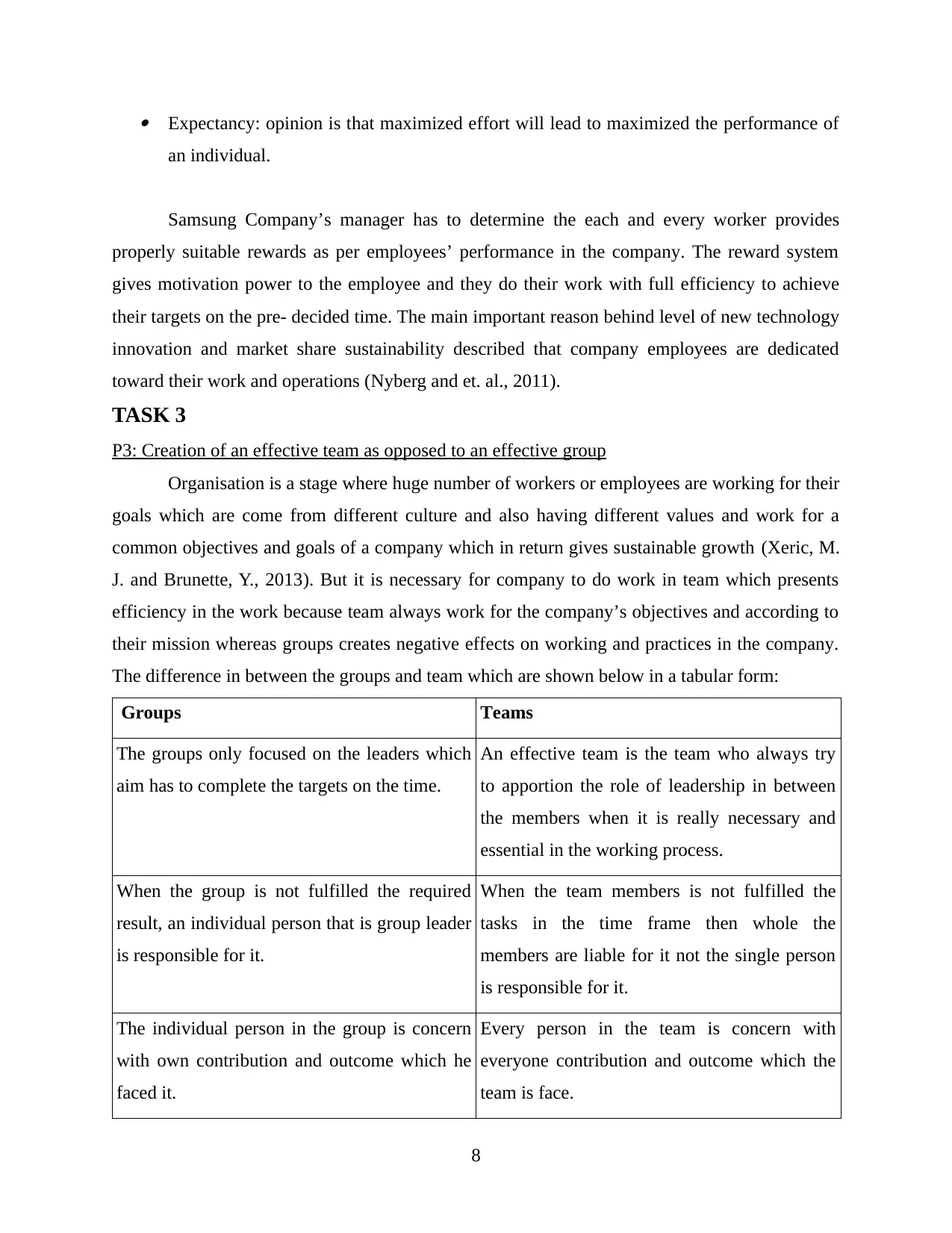
Expectancy: opinion is that maximized effort will lead to maximized the performance of
an individual.
Samsung Company’s manager has to determine the each and every worker provides
properly suitable rewards as per employees’ performance in the company. The reward system
gives motivation power to the employee and they do their work with full efficiency to achieve
their targets on the pre- decided time. The main important reason behind level of new technology
innovation and market share sustainability described that company employees are dedicated
toward their work and operations (Nyberg and et. al., 2011).
TASK 3
P3: Creation of an effective team as opposed to an effective group
Organisation is a stage where huge number of workers or employees are working for their
goals which are come from different culture and also having different values and work for a
common objectives and goals of a company which in return gives sustainable growth (Xeric, M.
J. and Brunette, Y., 2013). But it is necessary for company to do work in team which presents
efficiency in the work because team always work for the company’s objectives and according to
their mission whereas groups creates negative effects on working and practices in the company.
The difference in between the groups and team which are shown below in a tabular form:
Groups Teams
The groups only focused on the leaders which
aim has to complete the targets on the time.
An effective team is the team who always try
to apportion the role of leadership in between
the members when it is really necessary and
essential in the working process.
When the group is not fulfilled the required
result, an individual person that is group leader
is responsible for it.
When the team members is not fulfilled the
tasks in the time frame then whole the
members are liable for it not the single person
is responsible for it.
The individual person in the group is concern
with own contribution and outcome which he
faced it.
Every person in the team is concern with
everyone contribution and outcome which the
team is face.
8
an individual.
Samsung Company’s manager has to determine the each and every worker provides
properly suitable rewards as per employees’ performance in the company. The reward system
gives motivation power to the employee and they do their work with full efficiency to achieve
their targets on the pre- decided time. The main important reason behind level of new technology
innovation and market share sustainability described that company employees are dedicated
toward their work and operations (Nyberg and et. al., 2011).
TASK 3
P3: Creation of an effective team as opposed to an effective group
Organisation is a stage where huge number of workers or employees are working for their
goals which are come from different culture and also having different values and work for a
common objectives and goals of a company which in return gives sustainable growth (Xeric, M.
J. and Brunette, Y., 2013). But it is necessary for company to do work in team which presents
efficiency in the work because team always work for the company’s objectives and according to
their mission whereas groups creates negative effects on working and practices in the company.
The difference in between the groups and team which are shown below in a tabular form:
Groups Teams
The groups only focused on the leaders which
aim has to complete the targets on the time.
An effective team is the team who always try
to apportion the role of leadership in between
the members when it is really necessary and
essential in the working process.
When the group is not fulfilled the required
result, an individual person that is group leader
is responsible for it.
When the team members is not fulfilled the
tasks in the time frame then whole the
members are liable for it not the single person
is responsible for it.
The individual person in the group is concern
with own contribution and outcome which he
faced it.
Every person in the team is concern with
everyone contribution and outcome which the
team is face.
8
Secure Best Marks with AI Grader
Need help grading? Try our AI Grader for instant feedback on your assignments.
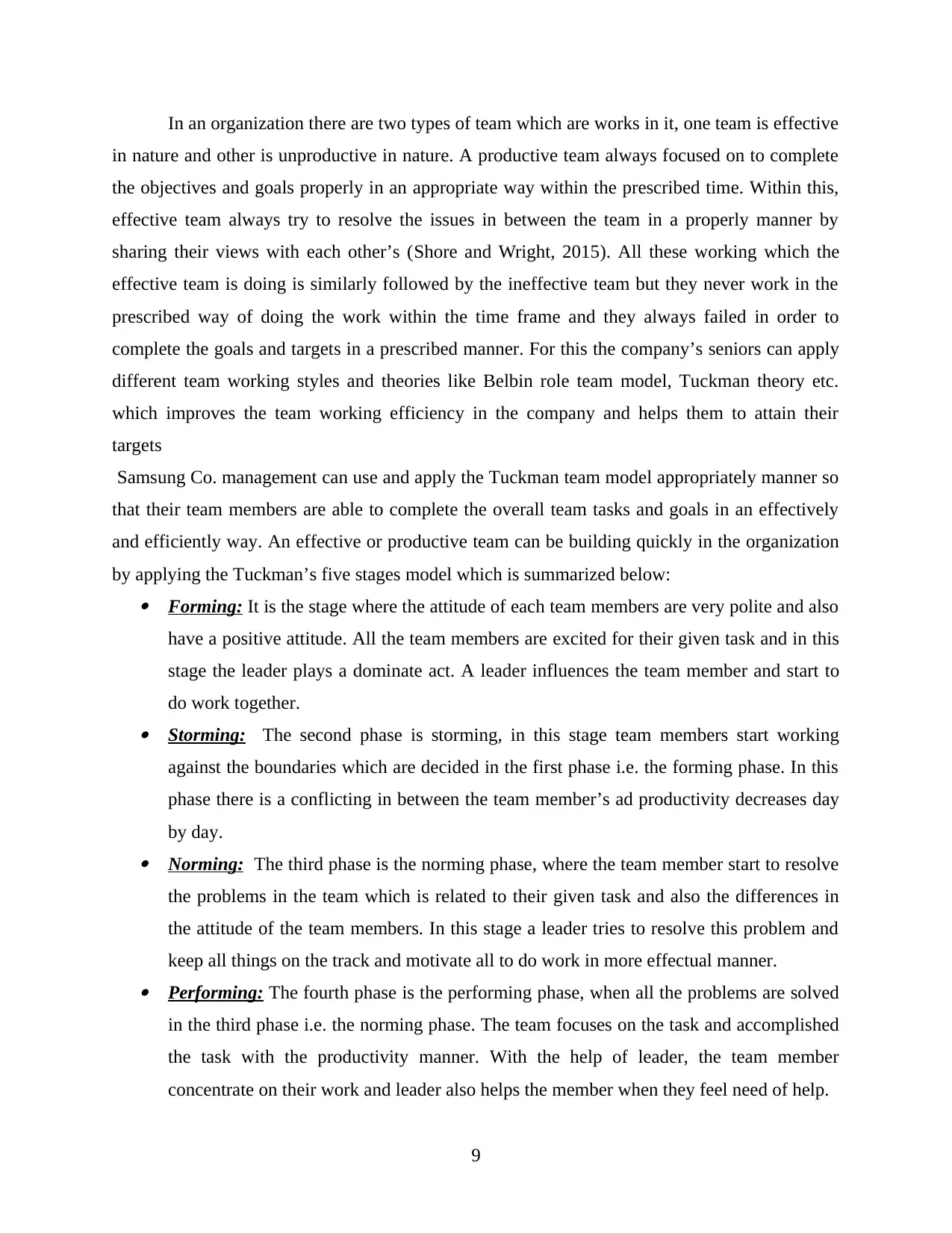
In an organization there are two types of team which are works in it, one team is effective
in nature and other is unproductive in nature. A productive team always focused on to complete
the objectives and goals properly in an appropriate way within the prescribed time. Within this,
effective team always try to resolve the issues in between the team in a properly manner by
sharing their views with each other’s (Shore and Wright, 2015). All these working which the
effective team is doing is similarly followed by the ineffective team but they never work in the
prescribed way of doing the work within the time frame and they always failed in order to
complete the goals and targets in a prescribed manner. For this the company’s seniors can apply
different team working styles and theories like Belbin role team model, Tuckman theory etc.
which improves the team working efficiency in the company and helps them to attain their
targets
Samsung Co. management can use and apply the Tuckman team model appropriately manner so
that their team members are able to complete the overall team tasks and goals in an effectively
and efficiently way. An effective or productive team can be building quickly in the organization
by applying the Tuckman’s five stages model which is summarized below: Forming: It is the stage where the attitude of each team members are very polite and also
have a positive attitude. All the team members are excited for their given task and in this
stage the leader plays a dominate act. A leader influences the team member and start to
do work together. Storming: The second phase is storming, in this stage team members start working
against the boundaries which are decided in the first phase i.e. the forming phase. In this
phase there is a conflicting in between the team member’s ad productivity decreases day
by day. Norming: The third phase is the norming phase, where the team member start to resolve
the problems in the team which is related to their given task and also the differences in
the attitude of the team members. In this stage a leader tries to resolve this problem and
keep all things on the track and motivate all to do work in more effectual manner. Performing: The fourth phase is the performing phase, when all the problems are solved
in the third phase i.e. the norming phase. The team focuses on the task and accomplished
the task with the productivity manner. With the help of leader, the team member
concentrate on their work and leader also helps the member when they feel need of help.
9
in nature and other is unproductive in nature. A productive team always focused on to complete
the objectives and goals properly in an appropriate way within the prescribed time. Within this,
effective team always try to resolve the issues in between the team in a properly manner by
sharing their views with each other’s (Shore and Wright, 2015). All these working which the
effective team is doing is similarly followed by the ineffective team but they never work in the
prescribed way of doing the work within the time frame and they always failed in order to
complete the goals and targets in a prescribed manner. For this the company’s seniors can apply
different team working styles and theories like Belbin role team model, Tuckman theory etc.
which improves the team working efficiency in the company and helps them to attain their
targets
Samsung Co. management can use and apply the Tuckman team model appropriately manner so
that their team members are able to complete the overall team tasks and goals in an effectively
and efficiently way. An effective or productive team can be building quickly in the organization
by applying the Tuckman’s five stages model which is summarized below: Forming: It is the stage where the attitude of each team members are very polite and also
have a positive attitude. All the team members are excited for their given task and in this
stage the leader plays a dominate act. A leader influences the team member and start to
do work together. Storming: The second phase is storming, in this stage team members start working
against the boundaries which are decided in the first phase i.e. the forming phase. In this
phase there is a conflicting in between the team member’s ad productivity decreases day
by day. Norming: The third phase is the norming phase, where the team member start to resolve
the problems in the team which is related to their given task and also the differences in
the attitude of the team members. In this stage a leader tries to resolve this problem and
keep all things on the track and motivate all to do work in more effectual manner. Performing: The fourth phase is the performing phase, when all the problems are solved
in the third phase i.e. the norming phase. The team focuses on the task and accomplished
the task with the productivity manner. With the help of leader, the team member
concentrate on their work and leader also helps the member when they feel need of help.
9
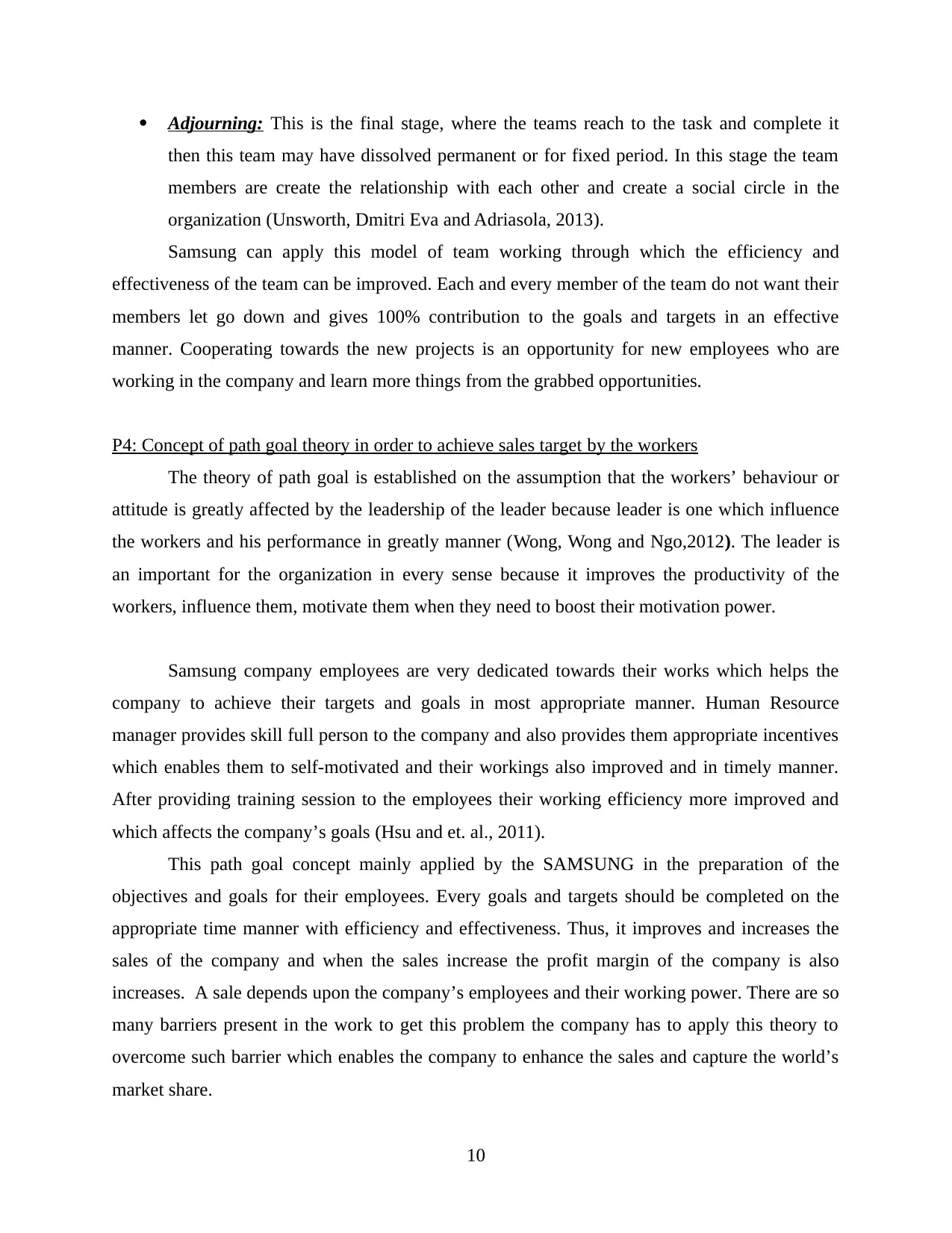
Adjourning: This is the final stage, where the teams reach to the task and complete it
then this team may have dissolved permanent or for fixed period. In this stage the team
members are create the relationship with each other and create a social circle in the
organization (Unsworth, Dmitri Eva and Adriasola, 2013).
Samsung can apply this model of team working through which the efficiency and
effectiveness of the team can be improved. Each and every member of the team do not want their
members let go down and gives 100% contribution to the goals and targets in an effective
manner. Cooperating towards the new projects is an opportunity for new employees who are
working in the company and learn more things from the grabbed opportunities.
P4: Concept of path goal theory in order to achieve sales target by the workers
The theory of path goal is established on the assumption that the workers’ behaviour or
attitude is greatly affected by the leadership of the leader because leader is one which influence
the workers and his performance in greatly manner (Wong, Wong and Ngo,2012). The leader is
an important for the organization in every sense because it improves the productivity of the
workers, influence them, motivate them when they need to boost their motivation power.
Samsung company employees are very dedicated towards their works which helps the
company to achieve their targets and goals in most appropriate manner. Human Resource
manager provides skill full person to the company and also provides them appropriate incentives
which enables them to self-motivated and their workings also improved and in timely manner.
After providing training session to the employees their working efficiency more improved and
which affects the company’s goals (Hsu and et. al., 2011).
This path goal concept mainly applied by the SAMSUNG in the preparation of the
objectives and goals for their employees. Every goals and targets should be completed on the
appropriate time manner with efficiency and effectiveness. Thus, it improves and increases the
sales of the company and when the sales increase the profit margin of the company is also
increases. A sale depends upon the company’s employees and their working power. There are so
many barriers present in the work to get this problem the company has to apply this theory to
overcome such barrier which enables the company to enhance the sales and capture the world’s
market share.
10
then this team may have dissolved permanent or for fixed period. In this stage the team
members are create the relationship with each other and create a social circle in the
organization (Unsworth, Dmitri Eva and Adriasola, 2013).
Samsung can apply this model of team working through which the efficiency and
effectiveness of the team can be improved. Each and every member of the team do not want their
members let go down and gives 100% contribution to the goals and targets in an effective
manner. Cooperating towards the new projects is an opportunity for new employees who are
working in the company and learn more things from the grabbed opportunities.
P4: Concept of path goal theory in order to achieve sales target by the workers
The theory of path goal is established on the assumption that the workers’ behaviour or
attitude is greatly affected by the leadership of the leader because leader is one which influence
the workers and his performance in greatly manner (Wong, Wong and Ngo,2012). The leader is
an important for the organization in every sense because it improves the productivity of the
workers, influence them, motivate them when they need to boost their motivation power.
Samsung company employees are very dedicated towards their works which helps the
company to achieve their targets and goals in most appropriate manner. Human Resource
manager provides skill full person to the company and also provides them appropriate incentives
which enables them to self-motivated and their workings also improved and in timely manner.
After providing training session to the employees their working efficiency more improved and
which affects the company’s goals (Hsu and et. al., 2011).
This path goal concept mainly applied by the SAMSUNG in the preparation of the
objectives and goals for their employees. Every goals and targets should be completed on the
appropriate time manner with efficiency and effectiveness. Thus, it improves and increases the
sales of the company and when the sales increase the profit margin of the company is also
increases. A sale depends upon the company’s employees and their working power. There are so
many barriers present in the work to get this problem the company has to apply this theory to
overcome such barrier which enables the company to enhance the sales and capture the world’s
market share.
10
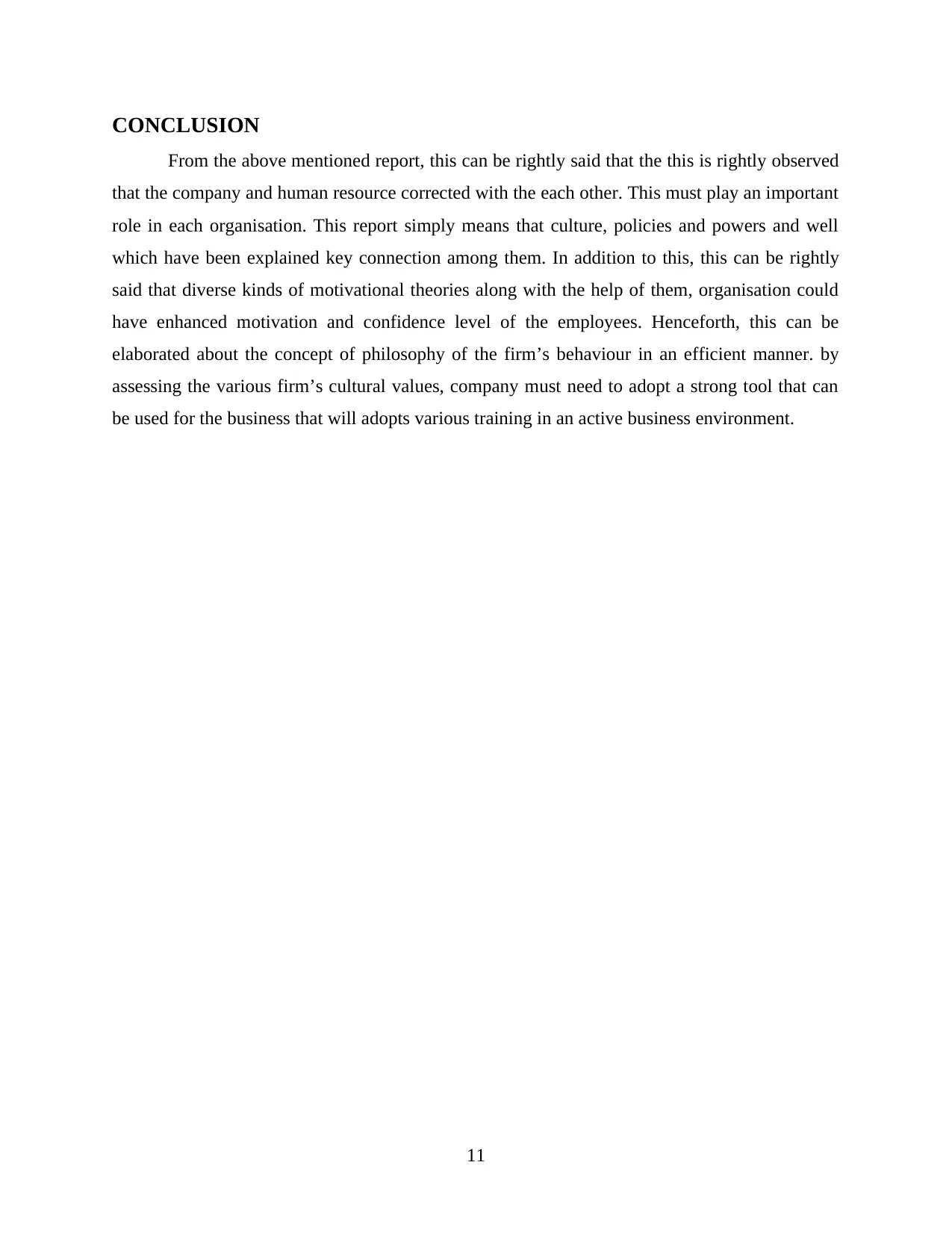
CONCLUSION
From the above mentioned report, this can be rightly said that the this is rightly observed
that the company and human resource corrected with the each other. This must play an important
role in each organisation. This report simply means that culture, policies and powers and well
which have been explained key connection among them. In addition to this, this can be rightly
said that diverse kinds of motivational theories along with the help of them, organisation could
have enhanced motivation and confidence level of the employees. Henceforth, this can be
elaborated about the concept of philosophy of the firm’s behaviour in an efficient manner. by
assessing the various firm’s cultural values, company must need to adopt a strong tool that can
be used for the business that will adopts various training in an active business environment.
11
From the above mentioned report, this can be rightly said that the this is rightly observed
that the company and human resource corrected with the each other. This must play an important
role in each organisation. This report simply means that culture, policies and powers and well
which have been explained key connection among them. In addition to this, this can be rightly
said that diverse kinds of motivational theories along with the help of them, organisation could
have enhanced motivation and confidence level of the employees. Henceforth, this can be
elaborated about the concept of philosophy of the firm’s behaviour in an efficient manner. by
assessing the various firm’s cultural values, company must need to adopt a strong tool that can
be used for the business that will adopts various training in an active business environment.
11
Paraphrase This Document
Need a fresh take? Get an instant paraphrase of this document with our AI Paraphraser
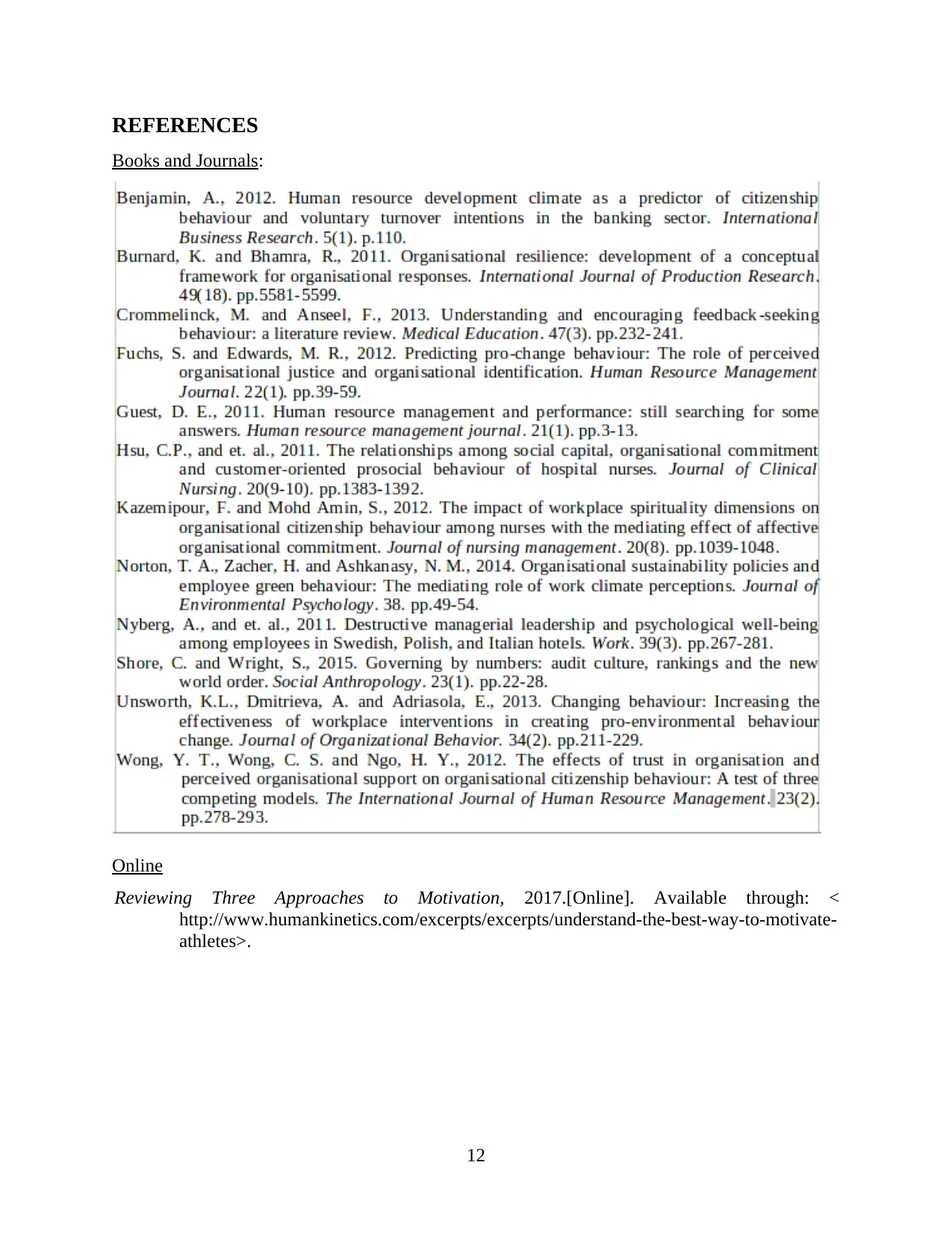
REFERENCES
Books and Journals:
Online
Reviewing Three Approaches to Motivation, 2017.[Online]. Available through: <
http://www.humankinetics.com/excerpts/excerpts/understand-the-best-way-to-motivate-
athletes>.
12
Books and Journals:
Online
Reviewing Three Approaches to Motivation, 2017.[Online]. Available through: <
http://www.humankinetics.com/excerpts/excerpts/understand-the-best-way-to-motivate-
athletes>.
12
1 out of 14
Related Documents
Your All-in-One AI-Powered Toolkit for Academic Success.
+13062052269
info@desklib.com
Available 24*7 on WhatsApp / Email
![[object Object]](/_next/static/media/star-bottom.7253800d.svg)
Unlock your academic potential
© 2024 | Zucol Services PVT LTD | All rights reserved.





